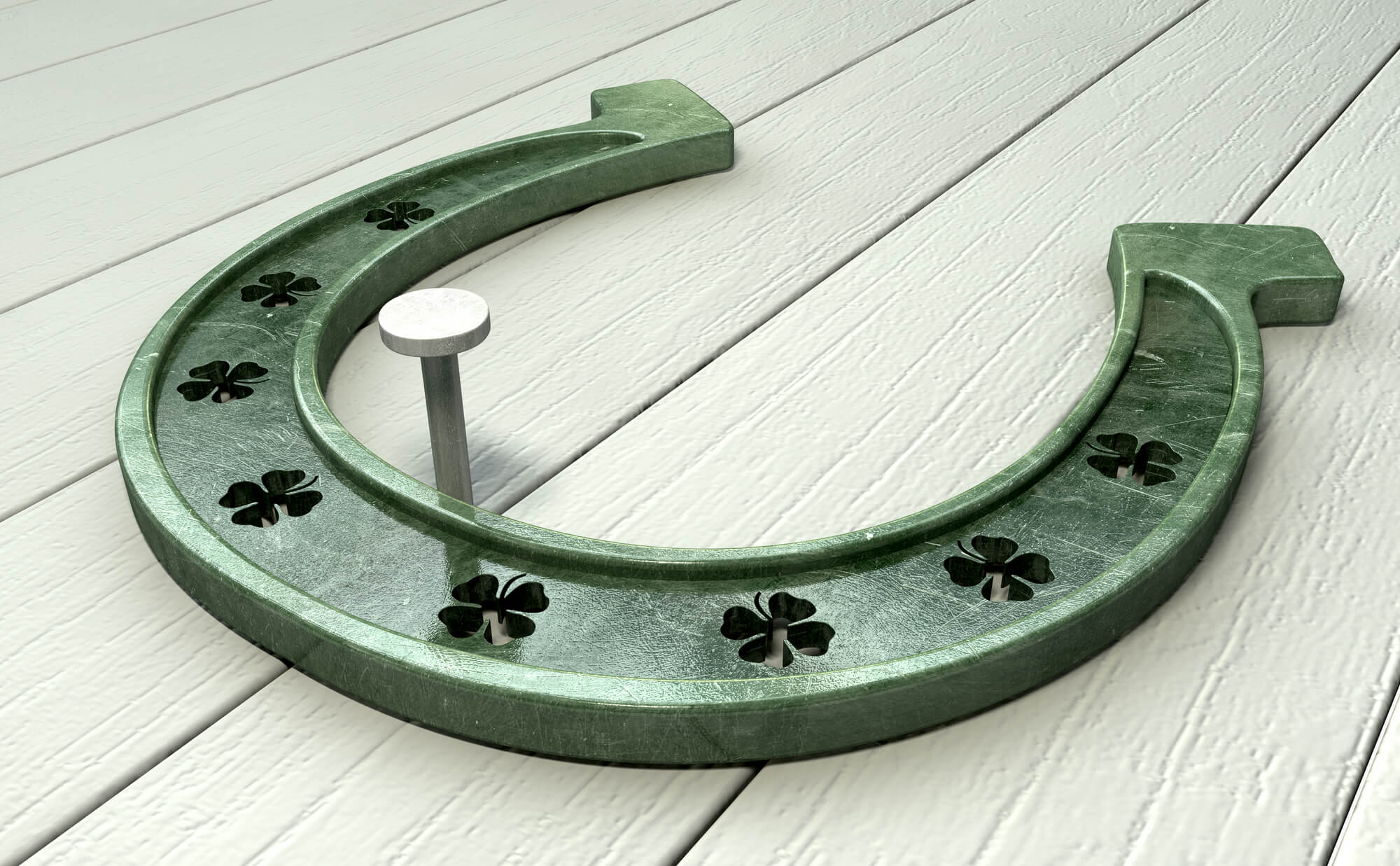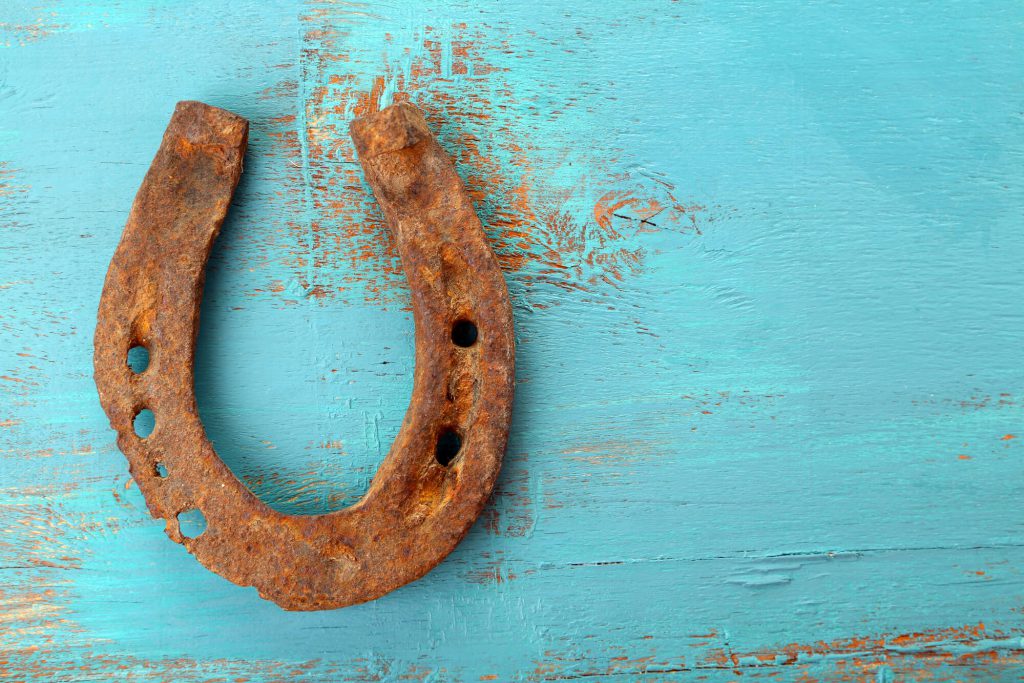Universally, the horse shoe has been recognized across cultures and generations. It reflects deep-seated symbolic meanings extending from good luck and protection to spiritual significances extending beyond all these. In this article, we will be talking about the interestingly symbolic horseshoe, its spiritual meanings, how it is believed to be a bringer of good luck, and then finally conclude by explaining the biblical interpretation of the horseshoe. First up though is the double horseshoe.
Meaning of horseshoe
In its simplest form, a horseshoe means good luck and protection as a symbol.
It pretty much goes back to a number of folkloric traditions found in different parts of the world. Early European and Celtic cultures thought that the iron that formed a horseshoe warded off evil spirits, and the crescent shape of the horseshoe was associated with moon goddesses which meant fertility and prosperity.
Symbolic meaning of the orientation of horseshoe also influences. When hung with ends facing up on both sides (making a ‘U’), it is believed to gather luck and retain it from spilling over. On the other hand, if it is hung with the ends pointing down then it is said to pour its luck unto those who pass under.
Spiritual Meaning of Horseshoe
Spiritually, the horseshoe makes a powerful protective sign. It contains iron which is said to push away the malevolent spirits and energies. Iron is a spiritual grounding metal in many beliefs and stands for strength and resilience thus making the horseshoe a shield from all negativity.
What further connects it to spirituality is its shape of a crescent as the moon in crescent has been an important spiritual symbol in many practices signifying cycles, femininity and the waxing and waning of energies.
Meaning of Lucky Horseshoe

The horseshoe was a lucky charm equivocal in many cultures. Actually, this association goes way back to the legend of Saint Dunstan who was an archbishop and blacksmith in the 10th century. Legend has it that the devil came to Dunstan and asked him to shoe his foot. Instead, Dunstan continued nailing another shoe onto the devil’s foot, causing him much pain. Dunstan agreed to remove it only after the devil promised never to enter a place where a horseshoe is hung.
Thus came into being the tradition of keeping a horseshoe hung over the entrance of a house, signifying that it kept the devil himself, and consequently all evil away. The horseshoe therefore has often been regarded as an amulet that brings good luck and guards against ill luck or misfortune.
The Horseshoe and its History of Evolution
The horseshoe, today being one of the most universally known symbols in many parts of the world had a historical mosaic passing through different epochs and civilizations. Its definition merely, and its symbolism itself, having indeed changed over time signaling so much regarding how it was able to prevail despite the several civilizational epochs.
| Time Period | Significance |
|---|---|
| Ancient Europe & Celtic Regions | What iron was made to be horseshoes with was to keep the dwelling away from evil spirits. The crescent shape in itself was something that was venerated due to it being a representation of the moon and its deities. |
| 10th Century | Legend of Saint Dunstan arose, connecting the horseshoe to devil protection and strengthening its status as a talisman of good luck. |
| Renaissance Era | Artists and scholars began incorporating the horseshoe in their work reflecting its magnitude and culture-related beliefs of the time. |
Modern Times Transition
The horseshoe symbolism transited the ages and adapted to changing environment. The core essence remained preserved inside the horseshoe but many a new interpretation and uses of it came into play that made it versatile and enduring symbol.
Horseshoe Through Cultures
This universal appeal is evidenced in its presence across all the diverse cultures; the horseshoe is to be found in each, each one imbued with distinct meanings and uses.
- Asia: The horseshoe as a symbol of luck is considered in some parts of Asia, so its present as a gift during the housewarming ceremony of a new home means to bless the family with lots of money in the house.
- In the Middle East: Some horseshoes are put not for luck but for protection from negative energies in the doorways.
- Latin America: Folklore says horseshoes found on roads or trails bring good luck, especially when carried or put in a home.
In some cultures, the belief about finding a horseshoe has developed to needing the open end of the shoe to be facing the finder. The horseshoe acts as a cup to collect and contain good fortune luck.
United under Belief
Despite the various interpretations, a common thread runs through all cultures: the faith in the horseshoe’s ability to bring good fortune and ward off the malicious. This shared inclination underlines the horseshoe as being universally resonant to all people that it bridges cultural gaps.
Horseshoe Biblical Significance
Although there is no direct physical appearance of the horseshoe in biblical books, its symbolism has been interpreted with a Christian lens, drawing connections to biblical teachings and beliefs.
| Aspect | Biblical Interpretation |
|---|---|
| Material | Iron, as the main composition of horseshoes, is traditionally associated with strength in the bible. In a spiritual context, it is said to serve as a repellent to evil beings thus lining up perfectly well to the beliefs that hostile powers cannot withstand the touch of iron. |
| Shape | The believers open their arms to symbolize the U-shape of the horseshoe indicating the readiness to receive grace, blessings and protection from God. |
| Protection | From this passage, biblical teachings emphasize the nature of God’s protection over believers and also the way the horseshoe is believed to protect. The horseshoe could therefore act as a reminder of the divine protection. |
Such interpretations, although not overtly provided for in biblical texts, lend a further meaning to the symbol of the horseshoe in light of Christianity. It speaks to the symbolic character of all things and how it is that symbols resonate with a wide variety of belief systems given their essentially adaptable character.
Double Horseshoe Meaning
A single horseshoe, in and of itself, has centuries of reputation as a good luck charm. The double horseshoe symbol takes two horseshoes joined at the ends. It is a symbol of double luck, doubled protection and doubled prosperity. It is often affixed in connection with successful partnerships in business or personal life due to its connection as a symbol for a solid union blessed with good fortune.
Like any symbol, the horseshoe can have different meanings given cultural, personal, or conditional context one using it in. Still, the central theme applies to its large functions: as an emblem for good luck, protecting and giving strength to something, representing through space and time and often does not differ among countries.
Horse Shoe in the Dreams

It has always been said that dreams are the windows of our subconscious, and these dreams may hold great meanings when motives like the horseshoe are being integrated within them. The horseshoe in a dream may talk about one’s innermost desires, fears, or hopes.
What Does Seeing a Horseshoe Mean in a Dream
When horseshoe graces our dreams, the context seems to be important as well. Is it shiny and new or old and rusted? Is it alone or with other symbols in a set-up? These nuances could then provide additional insights.
- Shiny Horseshoe: A shiny horseshoe can be a symbol that they would lead to good fortunes, success as well as the right change in their journey of life.
- Rusted Horseshoe: On the flip side, a rusty or rusted horseshoe can indicate lost chances as well as regret.
- Horseshoe with Other Symbols: With the presence of other symbols, one should learn how to interpret them altogether. For example, a horseshoe that is near the door may symbolize protection or even be perceived as a barrier for evil from getting in.
Assimilated Message
Although dream interpretations can be used as a guide, it is essential to remember absolute importance of one’s personal feelings. What does the representation of this horseshoe mean personally to you? Does it evoke feeling of the past glory time, little hope or maybe just nonchalance? Reflecting on these emotions might give a more personal understanding of the dream message.
Looking For Clarity?
If you’re fascinated by the appearance of a horseshoe in your dream and would like further clarification, then you could try maintaining a dream journal. Keeping record of your dreams and the feelings they elicit might help you make sense of them over time and this could be the guide that will tell you that life’s journey is one best undertaken with confidence and purpose.
Frequently Asked Questions
Why horseshoe is considered as thing which bring lucks?
The horseshoe is considered as a lucky charm because the horseshoe is made of iron and its shape is crescent.
The metal iron was regarded as the potent metal that repelled the evil spirits especially in European and Celtic cultures. The crescent shape of a horseshoe has also been associated with moon goddesses and its powerful symbolism has generally brought forward meanings of fertility and prosperity. These two beliefs were later joined to reach a general belief which stated that the horseshoe was a charm for good luck and repelling evil spirits.
What is the meaning of a horseshoe upside down?
An upside-down horseshoe in which its ends are pointing downwards is believed to imply pouring luck on those who pass beneath it.
Others also believe that it does imply luck flowing outwards to bless the surroundings. However, such interpretation can be different based on culture and personal understanding.
Does the horseshoe lucky faces up or down?
The horseshoe being lucky is in both orientations.
Facing the horseshoe up, into a ‘U’ shape and upwards is believed to collect and hold onto good luck.
Conversely, there are beliefs that indicate it showers luck beneath as it faces down. The preferred orientation often depends on cultural traditions and individual’s belief.
What does the evil eye on a horseshoe mean?
The two symbologies when merged, the evil eye with the horseshoe increases both their protectiveness. Though general negativity and luck which are kept away by the horseshoe and brought in respectively, the evil eye specific keeps away negative energies originated from malicious intentions and envy. Together they form a potent amulet that offers protection in general from the happenstance of bad luck as well as protection specifically against evil.
How did the legend of Saint Dunstan help shape a symbolism for the horseshoe?
The legend of Saint Dunstan, wherein a blacksmith goes forth and becomes Archbishop of Canterbury, takes the lore of the horseshoe to another level altogether.
According to the legend, the devil had come to Dunstan and asked him to shoe his horse.
Instead, Dunstan nailed a horseshoe to the devil’s foot, causing the devil great pain.
He only relented on being allowed to remove it once the devil swore never to enter a premises that decided to display a horseshoe.
The myth reinforced the belief of a horseshoe in being protective towards a house especially against evil.
Why is iron called as protective material?
The reputation of iron’s protective property goes back to early days. Iron was considered by many cultures as repelling the place for evil spirits and superpowers.
It was a material of choice for production of tools, amulets as well as weapons due to its strength and longevity.
Later, these properties are transferred to the sphere of spiritual and symbolic, making iron things like horseshoes gain the ability to act as powerful talismans in the fight against negativity.
A found horseshoe can bring more luck than purchased?
A horseshoe that has been found randomly is believed to contain more luck than one that’s bought. That the luck of a lucky horseshoe is better if it is found with a sense of serendipity, and especially found with the open end facing the finder, was conceived of as a direct infusion of blessing in both purity and good fortune. Though a bought horseshoe could still serve as a symbol of protection and luck, an unplanned gift of having found a horseshoe is often considered more potent in its lucky charm.
Conclusion
Whether viewed as a simple charm for good luck, a guardian talisman warding off evil, or a spiritual symbol with deep layers of meaning, the horseshoe holds an unique place in human culture. It is puzzling or rather endurable symbolism, which bridged the banality and the spiritual, the antiquity and now; thus to say, it brings to life the universal appeal of the horseshoe. However one may interpret that symbol though, but it definitely carries a message of optimism, strength, in light of its persistent positive spirit.

